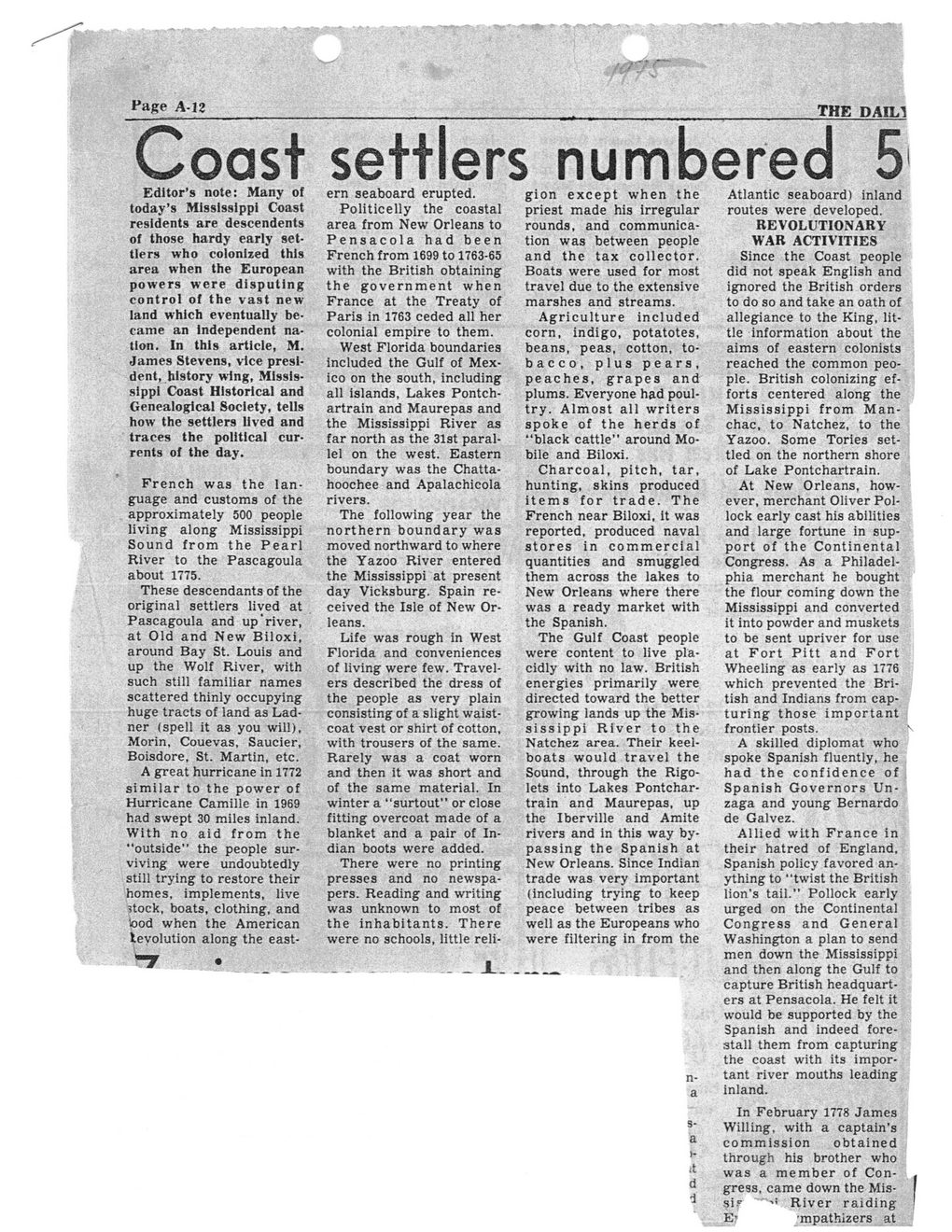This text was obtained via automated optical character recognition.
It has not been edited and may therefore contain several errors.
Page A-12 THE DAIL1 settlers numbered 5 Coast Editor’s note: Many of today’s Mississippi Coast residents are descendents of those hardy early settlers who colonized this area when the European powers were disputing control of the vast new land which eventually became an independent nation. In this article, M. James Stevens, vice president, history wing, Mississippi Coast Historical and Genealogical 8ociety, tells how the settlers lived and traces the political currents of the day. French was the language and customs of the approximately 500 people living along Mississippi Sound from the Pearl River to the Pascagoula about 1775. These descendants of the original settlers lived at Pascagoula and up'river, at Old and New Biloxi, around Bay St. Louis and up the Wolf River, with such still familiar names scattered thinly occupying huge tracts of land as Ladner (spell it as you will), Morin, Couevas, Saucier, Boisdore, St. Martin, etc. A great hurricane in 1772 similar to the power of Hurricane Camille in 1969 had swept 30 miles inland. With no aid from the “outside” the people surviving were undoubtedly still trying to restore their homes, implements, live 5tock, boats, clothing, and lood when the American levolution along the east- *7 • ern seaboard erupted. Politicelly the coastal area from New Orleans to Pensacola had been French from 1699 to 1763-65 with the British obtaining the government when France at the Treaty of Paris in 1763 ceded all her colonial empire to them. West Florida boundaries included the Gulf of Mexico on the south, including all islands, Lakes Pontch-artrain and Maurepas and the Mississippi River as far north as the 31st parallel on the west. Eastern boundary was the Chattahoochee and Apalachicola rivers. The following year the northern boundary was moved northward to where the Yazoo River entered the Mississippi at present day Vicksburg. Spain received the Isle of New Orleans. Life was rough in West Florida and conveniences of living were few. Travelers described the dress of the people as very plain consisting of a slight waistcoat vest or shirt of cotton, with trousers of the same. Rarely was a coat worn and then it was short and of the same material. In winter a “surtout” or close fitting overcoat made of a blanket and a pair of Indian boots were added. There were no printing presses and no newspapers. Reading and writing was unknown to most of the inhabitants. There were no schools, little reli- ________ . _ _L_ gion except when the priest made his irregular rounds, and communication was between people and the tax collector. Boats were used for most travel due to the extensive marshes and streams. Agriculture included corn, indigo, potatotes, beans, peas, cotton, tobacco, plus pears, peaches, grapes and plums. Everyone had poultry. Almost all writers spoke of the herds of “black cattle" around Mobile and Biloxi. Charcoal, pitch, tar, hunting, skins produced items for trade. The French near Biloxi, it was reported, produced naval stores in commercial quantities and smuggled them across the lakes to New Orleans where there was a ready market with the Spanish. The Gulf Coast people were content to live placidly with no law. British energies primarily were directed toward the better growing lands up the Mis-sissippi River to the Natchez area. Their keel-boats would travel the Sound, through the Rigo-lets into Lakes Pontchar-train and Maurepas, up the Iberville and Amite rivers and in this way bypassing the Spanish at New Orleans. Since Indian trade was very important (including trying to keep peace between tribes as well as the Europeans who were filtering in from the n- a s- a H ,t d ■i Atlantic seaboard) inland routes were developed. REVOLUTIONARY WAR ACTIVITIES Since the Coast people did not speak English and ignored the British orders to do so and take an oath of allegiance to the King, little information about the aims of eastern colonists reached the common people. British colonizing efforts centered along the Mississippi from Man-chac, to Natchez, to the Yazoo. Some Tories settled on the northern shore of Lake Pontchartrain. At New Orleans, however, merchant Oliver Pollock early cast his abilities and large fortune in support of the Continental Congress. As a Philadelphia merchant he bought the flour coming down the Mississippi and converted it into powder and muskets to be sent upriver for use at Fort Pitt and Fort Wheeling as early as 1776 which prevented the British and Indians from capturing those important frontier posts. A skilled diplomat who spoke Spanish fluently, he had the confidence of Spanish Governors Un-zaga and young Bernardo de Galvez. Allied with France in their hatred of England, Spanish policy favored anything to “twist the British lion's tail.” Pollock early urged on the Continental Congress and General Washington a plan to send men down the Mississippi and then along the Gulf to capture British headquarters at Pensacola. He felt it would be supported by the Spanish and indeed forestall them from capturing the coast with its important river mouths leading inland. In February 1778 James Willing, with a captain's commission obtained through his brother who was a member of Congress, came down the Missis ” River raiding E’ mpathizers at

Hancock County History General Newspaper Clippings Coast-settlersDaily-Herald-Feb-(19751)